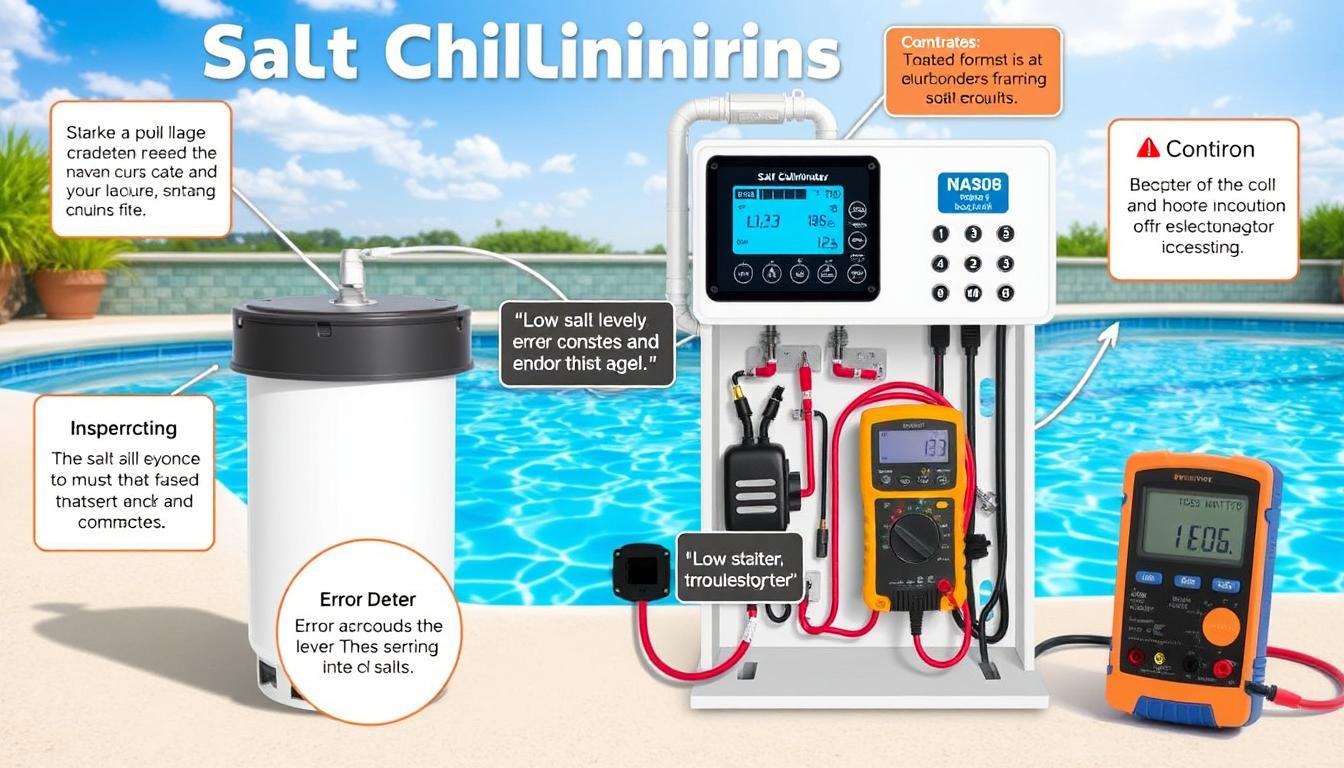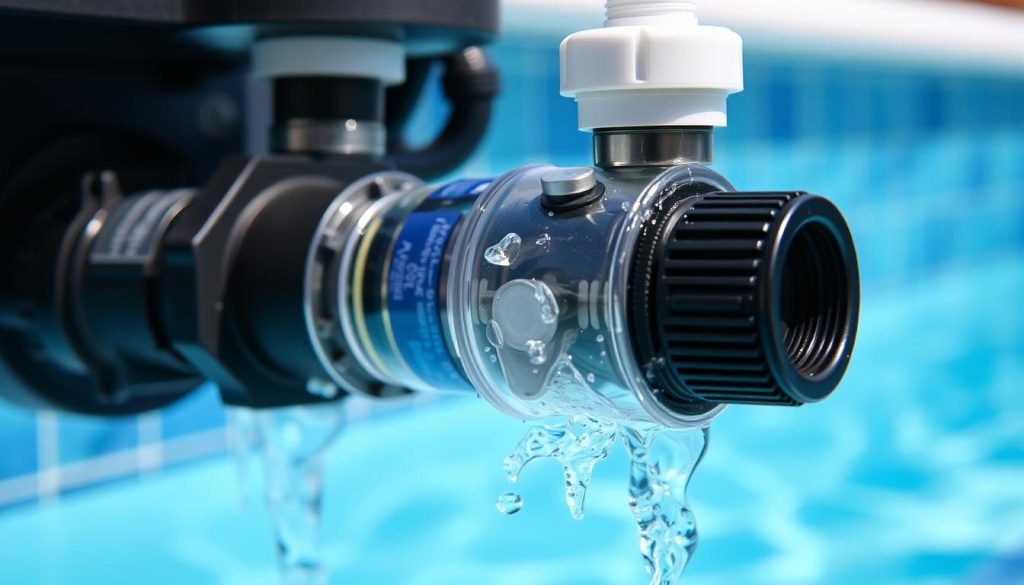
Salt chlorinators usually last 3-5 years, even with good care. When they stop working, it can be very frustrating. Low chlorine levels, no flow indication, and flashing lights are signs of trouble.
Without a working salt cell, pools can become dirty and unsafe. Algae and bacteria can grow quickly. This can lead to health risks for swimmers.
Regular upkeep is key to keeping your salt chlorinator running well. Check salt levels often. Clean the salt cell as needed. Make sure water flows properly through the system.
Fixing problems quickly helps your chlorinator last longer. This means you can enjoy a clean pool all season. Let’s look at common issues and how to fix them.
Common Reasons for Salt Chlorinator Malfunction
Salt chlorinator issues can frustrate pool owners. Factors like poor water flow, wrong salt levels, and calcium build-up can cause problems. Understanding these issues helps us fix them quickly.

Insufficient Water Flow
Salt chlorinators need good water flow to work well. Low flow rates can stop chlorine production. Clogged pumps, dirty filters, or closed valves can reduce water flow.
Clear housings let us check for tiny bubbles. These bubbles show that salt is making chlorine. The water may look slightly cloudy.
Improper Salt Levels
Salt cells need the right salinity to make chlorine. Most systems work best at 3000 ppm. Some salt systems show salt levels and warn when they’re low.
Salt sensors can be wrong. It’s smart to use salt test strips to check levels. This ensures the chlorinator works in the best range.
| Salinity Range (ppm) | Effect on Salt Chlorinator |
|---|---|
| Below 2500 | Insufficient salt for effective chlorine production |
| 2500-3500 | Optimal range for salt chlorinator operation |
| Above 3500 | Excessive salt can lead to corrosion and damage to pool equipment |
Calcium Build-up on Salt Cell
Calcium can build up on salt cells over time. This slows water flow and stops electrolysis. Salt systems can self-clean, but regular checks are still needed.
High calcium, pH, or alkalinity can cause scale deposits. Manual cleaning may be necessary to keep the cell working well.
High calcium levels on the chlorinator cell can cause scaling on electrodes, affecting its functioning. It is advised to clean the cell if scale build-up occurs to prevent permanent damage.
Faulty Power Supply or Connections
Salt cells need the right voltage to work. Loose wires or damaged cords can cause power issues. Check the voltage with a multimeter.
Set the multimeter to DC volts. Compare readings to the specs in the manual. Do this while the cell is on high or boost mode.
Regular maintenance keeps salt chlorinators working well. Check the cell, salt levels, and water flow often. This prevents many problems before they start.
why is my salt chlorinator not working
Is your salt chlorinator acting up? Don’t worry. We’ll help you fix it. Let’s explore some common issues and their solutions.
Checking for Blown Fuses or Tripped Breakers
First, check for power issues. Look for blown fuses or tripped breakers. No lights on the control panel? That’s a power problem.
Check your main electrical panel for tripped breakers. Some units have internal fuses too. Test your GFCI outlet if you have one.
Feel the power cord. If it’s warm, power is reaching the unit.
Inspecting Salt Cell for Damage or Corrosion
Next, look at the salt cell. Check for damage or corrosion. Clean corroded terminals with an old toothbrush and acid solution.
Clear housings let you see inside. Look for tiny bubbles or cloudy water. That’s chlorine being made.
No clear housing? Remove the cell and put it in salty pool water. Turn it on and check for bubbles.
Testing Salt and Chlorine Levels
Wrong salt and chlorine levels can cause problems. Use test kits to check levels. Aim for 2700-3400ppm salt.
Low salt can harm electrodes. Unsure? Get a pro to test your water.
| Parameter | Ideal Range |
|---|---|
| Salt | 2700-3400ppm |
| Free Chlorine | 1-3ppm |
| pH | 7.2-7.6 |
| Alkalinity | 80-120ppm |
| Calcium Hardness | 200-400ppm |
Many factors can lower chlorine levels fast. Test free chlorine weekly. Adjust your chlorinator settings as needed.
Cleaning Salt Cell to Remove Calcium Deposits
High calcium can cause scale build-up. This hurts performance. Clean the cell to prevent damage.
Scale slows water flow and messes with electrolysis. Regular cleaning keeps your chlorinator working well.
A well-maintained salt chlorinator not only keeps your pool water clean and safe but also extends the life of the unit, saving you money in the long run.
Follow these steps to keep your chlorinator running smoothly. You’ll have a clean, healthy pool all season long.
Conclusion
Regular maintenance and quick troubleshooting of salt chlorinators can save time and money. Check power supply, water flow, salt levels, and chlorine levels. Inspect the salt cell for calcium build-up to identify issues early.
Balancing pool chemistry and cleaning the salt cell regularly are key to extending equipment life. These simple steps can prevent many common problems.
If issues persist after troubleshooting, consider professional help. Pool experts can diagnose complex problems and suggest cost-effective solutions for your specific situation.
Sometimes, replacing an old or damaged salt chlorinator is more economical than repairs. Consider the equipment’s age and problem severity when deciding between repair and replacement.
Stay proactive about salt chlorinator maintenance and troubleshooting. This approach ensures a clean, safe, and enjoyable pool for years to come.







